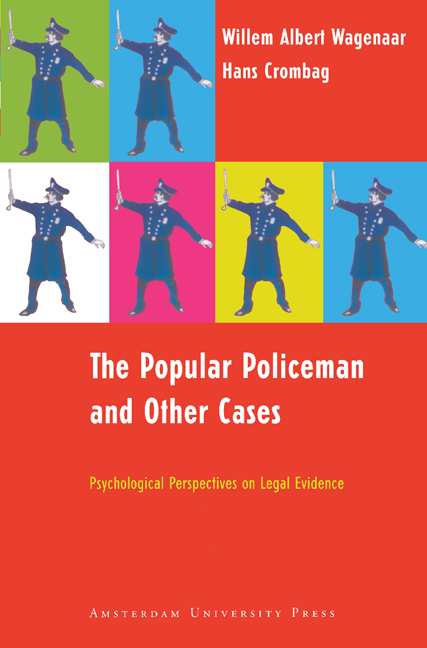Book contents
- Frontmatter
- Contents
- Foreword
- 1 Illegal Gambling or the Victory Travel Club
- 2 On Causal Reasoning or Death in the Warmoesstraat
- 3 Consumer Confusion or Potato Chips and Olive Oil
- 4 Fiction and Reality of ‘the Average Individual’ or the Case of Old Mr. Lane
- 5 Case Histories and Scientific Proof or the Case of JR
- 6 Not a Good Story or the Disappearance of Maddy and Vicky
- 7 Conflicting Scenarios or the Case of the Man who Needed a Companion
- 8 Two Processes Obstructing the Accuracy of Long-Term Memory or the Case of the Stolen Mercedes
- 9 Confessions after Repeated Interrogation or the Putten Murder Case
- 10 Collaborative Storytelling or the Artist’s Models and an Angry Neighbourhood
- 11 Allegation of Sexual Child Abuse in a Case of Disputed Visitation or Cindy's Story
- 12 Psychogenic Amnesia or the Case of the Amnesic Strangler
- 13 Obeying Reflexes or Death on the Climbing Wall
- 14 Visual Acuity or Shooting Mimi the Cat
- 15 Sexual Semiotics or the Case of the Popular Policeman
- Postscript: Psychological Expertise and the Law
- Bibliography
- Name Index
- Subject Index
6 - Not a Good Story or the Disappearance of Maddy and Vicky
Published online by Cambridge University Press: 16 February 2021
- Frontmatter
- Contents
- Foreword
- 1 Illegal Gambling or the Victory Travel Club
- 2 On Causal Reasoning or Death in the Warmoesstraat
- 3 Consumer Confusion or Potato Chips and Olive Oil
- 4 Fiction and Reality of ‘the Average Individual’ or the Case of Old Mr. Lane
- 5 Case Histories and Scientific Proof or the Case of JR
- 6 Not a Good Story or the Disappearance of Maddy and Vicky
- 7 Conflicting Scenarios or the Case of the Man who Needed a Companion
- 8 Two Processes Obstructing the Accuracy of Long-Term Memory or the Case of the Stolen Mercedes
- 9 Confessions after Repeated Interrogation or the Putten Murder Case
- 10 Collaborative Storytelling or the Artist’s Models and an Angry Neighbourhood
- 11 Allegation of Sexual Child Abuse in a Case of Disputed Visitation or Cindy's Story
- 12 Psychogenic Amnesia or the Case of the Amnesic Strangler
- 13 Obeying Reflexes or Death on the Climbing Wall
- 14 Visual Acuity or Shooting Mimi the Cat
- 15 Sexual Semiotics or the Case of the Popular Policeman
- Postscript: Psychological Expertise and the Law
- Bibliography
- Name Index
- Subject Index
Summary
The theory of anchored narratives
Every criminal trial begins with an indictment, which is a brief rendition of who did what, when and where, according to the prosecution. At that point, the indictment is only an allegation in need of support by evidence. During the trial, it is the prosecution's task to offer such evidence. It is the defence counsel's task to test critically the evidence offered by the prosecution, if possible, to adduce evidence to the contrary. In an earlier book (Wagenaar, Van Koppen, & Crombag, 1993) we discussed at length the structure of proof in criminal cases. We dubbed it ‘the theory of anchored narratives’. Proof in a criminal case consists of an indictment containing a well-shaped narrative of what happened and in which each critical element needs to be supported by evidence in the form of a sub-story. This sub-story, in its turn, may need to be supported by evidence in the form of a sub-sub-story, etc., until each critical piece of evidence can be safely associated to a common-sense presumption (cf. Cohen, 1977), called an anchor, which is an assertion that common sense tells us needs no further exploration or discussion. We demonstrated an example of how one can execute the anchoring process in the previous chapter, where we gradually descended along the hierarchy of the nested (sub)stories that together constituted proof in a criminal case. The present chapter is concerned with the requirement that the indictment must contain a well-shaped narrative. If the indictment contains an a priori impossible or highly improbable narrative, there is no point in taking it to court. The question is, of course, what constitutes a well-shaped narrative or a good story.
Students of various disciplines have designed ‘story grammars’: sets of rules that a story must obey in order to be a good story. How to choose between those? We picked the one proposed by Bennett and Feldman (1981), because it is empirically based and developed in a legal context. They asked each of 85 students to tell a story. Half of those students were instructed to tell a true story, the other half to invent one.
- Type
- Chapter
- Information
- The Popular Policeman and Other CasesPsychological Perspectives on Legal Evidence, pp. 93 - 108Publisher: Amsterdam University PressPrint publication year: 2012



